#status quo is best is so very cultural in most japanese fiction
Explore tagged Tumblr posts
Note
I really like the theory of the cause being all the lives and "histories" that humanity has discarded or thrown away. It fits with Galahad's total lack of interest in helping Ritsuka and Mashu, as he seems like the type of "way too righteous hero" that probably didn't like the "system" to begin with.
It was an old theory of mine based on the PV (and how Nasu subtly compared Goetia’s actions with the Pruning System actions in the Moonlight Lostroom booklet). Before I thought about Chaldeas/Laplace connection tie-in and explored that angle too, I assumed was Marisbury who saw these when he activated Chaldeas and felt shame, but it could be its own content made from the Void (Animusphere chant has the formula). They don’t contradict themselves, because LAPLACE allows recording those things lost, TRISMEGISTUS runs simulations, CHALDEAS provide a pseudo model of Earth they can project into. While this made Animusphere family really dangerous, this and their shortcomings and hubris (Marisbury's and Olgamarie) are dragged into probably the colorless wishes of those who are gone (just like Olga herself), if there is no mastermind (there could be a mastermind, though). If there is a mastermind, I wonder if it’s our Marisbury or Animusphere, or from another timeline (or an Alter Ego). Cut for length.
They must create something new based on things that could have been that were already on the Planet. It's not the orthodox past the Beast manifests from, but elements of a fictional history. You must eliminate Panhistory to install that to prepare the Advent of the new “God.”U Olga can be ignorant of history now because she is born of a lostbelt tree of fantasy. Even so, she can still be Olga, because as the God/Beast, she has a fictional background she’s born from that changed her memories, she still is Olga. Those are probably feelings and needs she repressed too.
(And the priestess could have been Olga, if she still remains at all or has transformed into “Ultra Olga”, but her attitude from murderous and bitter to more empathetic with some people is completely understandable: she discarded too. Her inability to choose when Kirschtaria asked her in Atlantis is because she resigned and didn’t know what to choose).
(And addendum: I’m also sure her Sin and feelings, and her family mission to preserve the future got mixed in Chaldeas or the colorless Void made of this crushed grudge and stirred things too. I’m not saying is only her fault, but it’s going to be a part of this mess, which explains why Lev is trying to make her decide what she wants to do in Lostroom and why Kirschtaria asked her why she’s still silent about this: her choice will matter. Her choice even if it wasn’t fully formed, mattered in Melty Blood Backalley Nightmare too.
It’s many things that are happening but I have issues to string together this, that’s why I started by the “nature” of the “God of a Different Planet” to iron the contradictions that I don’t believe exist - they can be explained with clever loopholes).
Kirschtaria’s attempt to build a world where people are on more equal terms, to find an “answer”, wasn’t that his attempt to change the system of men without needing a god, and maybe (this is a little headcanon) hoping for humanity as collective to modify that system too. The counter force and system change with men (Lostbelt 3 is proof), so is not insane to assume that this godlike humanity would be able to collectively desire something else. In a world where losers and winners aren’t so marked, maybe their unconscious world logic will soften. Forgive me, I’m rambling about this.
Unfortunately, I don’t think Nasu’s going to break the status quo. He doesn’t dare. Just like death and painful things exist, this will go to “accept it happens” (Sugita’s taunts about reading your sacrificial offerings in the PV). We also must accept unfairness and inequality are a part of our world, and that won’t change. There are winners and losers. The best Guda and Mash can do is to treat the losers humanly despite their intention to deny them, and carry their wills and feelings. Like they would pass on someone else their feelings and wills should Panhistory decide it’s their turn to lose. I dislike the sentiment behind this. It’s why the battle against Kirschtaria left a bad taste in my mouth. The current world circumstances that desperately scream is time to stand up and change, and we get a lukewarm “it sucks, but it’s what we got” narrative is so frustrating!
#fgo ask#sigh#status quo is best is so very cultural in most japanese fiction#not all of them but unfortunately a lot
4 notes
·
View notes
Text
FEATURE: Japanese Myths And How They're Depicted In Horror Anime

No matter the time or place, the folklore and myths of the past always persist. The same can also be said for anime, especially when it comes to horror. Certain franchises, such as Shigeru Mizuki’s classic GeGeGe no Kitaro, have solidified the omnipresent status of traditional Japanese folk monsters in popular culture. Other series, such as Osamu Tezuka’s Dororo interpret traditional folklore in relation to historical periods and changing attitudes toward religion. More recently, series from the 2010s and 2000s, such as Bakemonogatari and Ghost Stories, interpret the classics with modern sensibilities. When it comes to stories with a penchant for horror, it would be far more surprising if they didn’t allude to a shared supernatural mythology — the ubiquity is the point.

Neko-Musume on her smartphone
The best horror always tries to do something new. While creatures like yōkai (a wide umbrella of supernatural entities) are well-known among English-speaking fans today thanks to series like Yokai Watch, these re-imaginings always tend to play fast and loose with fidelity. Wouldn’t it be boring if every vampire movie started and ended with Dracula? In a 2016 interview with The Comics Journal, veteran manga translator Zack Davisson emphasizes this important tendency to re-contextualize old folklore:
“It’s a tricky question, as it is impossible to say what is ‘actual folklore.’ Vampires bursting into flame is considered ‘authentic,’ but that actually comes from the films, not folkloric sources. Folklore evolves and [Shigeru] Mizuki is an important part of that evolution. If you trace them back, most yokai we know come from Toriyama Sekien, who also just made things up. In fact, I would say that making up yokai is part of the grand tradition of yokai! If you are a writer/artist working with yokai and not making up at least a few of your own, you are missing the point!”

The original spirit gun
So that’s all to say — there really is no such thing as a definitive, one-to-one story based on centuries of tradition. Yōkai, as endearing as they are, are also just one part of the equation. Long-running anime such as Folktales from Japan and fantasy series Inuyasha-continuation Yashahime: Princess Half-Demon either re-tell or draw inspiration from that folklore. But that’s beyond the scope of this piece. Whether it be adaptations of urban legends about school bathrooms or vengeful spirits, I hope this round-up helps any casual or long-time anime fan appreciate how these series reimagine supernatural traditions.
Fantastic Folklore: GeGeGe no Kitaro & Mononoke
The late Shigeru Mizuki’s most influential character, Kitaro, hardly needs any introduction. In his book Yokai Attack! The Japanese Monster Survival Guide, translator Matt Alt describes yōkai as “the attempts of the fertile human imagination to impose meaning and rationality on a chaotic, unpredictable, often difficult-to-explain world.” Many yōkai are quite strange and sometimes even comedic. Scholar-artists, such as the previously mentioned Toriyama Sekien, are largely credited with inspiring their uncanny visual representations, making them the perfect subject matter for an accessible series.
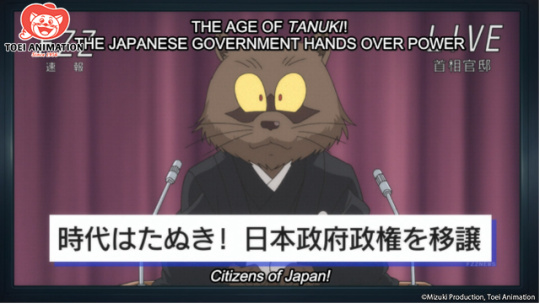
The tanuki plot world domination
The titular Kitaro himself is a half-human, half-yōkai one-eyed boy who travels between the human and spirit world to resolve monster-of-the-day conflicts with his friends. Although Mizuki’s Kitaro as we know it began serialization in 1960, Mizuki originally received permission to re-imagine the character from Masami Itō, who first created Kitaro in the 1930s in pre-war Japan. The most recent 2018 anime series re-establishes Kitaro in a modern setting, yet still adapts many of the most iconic stories. Characters such as Neko-Musume, based on volatile cat spirits called bakeneko, are updated with new designs while Kitaro mostly remains the same. Mizuki’s older creations, such as the jubokko (vampire tree) yōkai, are still featured alongside a new re-imagining of the “wall monster” nurikabe — inspired by the discovery of an Edo manuscript in 2007. The appeal of Kitaro isn’t so much the meticulous adherence to yōkai mythos, but rather Mizuki’s continual improvisation of the folklore-informed monster-making tradition.
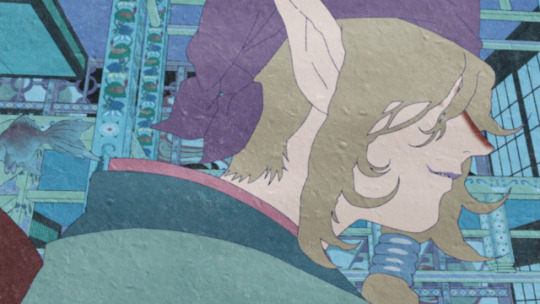
The Medicine Seller
Beyond Kitaro, other series, such as 2006’s Mononoke, dedicate entire storylines to a wider category of ayakashi (sea-bound yōkai) and funayūrei (boat spirits) written by none other than Chiaki J. Konaka. Later episodes feature bakeneko and nue (chimera monsters), but with a twist. The term mononoke itself refers to a variety of yōkai specifically referring to vengeful spirits possessing people or things. When it comes to series taking a more “fantastical” approach to folklore, both Mononoke and Kitaro thankfully never dissolve into simple rogue galleries of monsters — their (mostly) human protagonists largely remain the heart of their chilling saga.
Horror-Historical: Osamu Tezuka’s Dororo
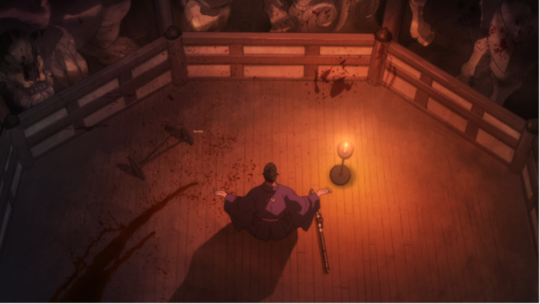
Lord Kagemitsu Daigo makes a pact with the demons (Source: Amazon)
In Anime and Its Roots in Early Japanese Monster Art scholar Zília Papp comments Mizuki’s “Kitaro characters became synonymous with yōkai in the postwar period, continuing to the present time” compared to his peers like Tezuka. But if Kitaro made yōkai big in comedic manga, then Tezuka’s short-lived Dororo manga drove this interest toward the historical context of the Sengoku Period, or the “warring states” era of feudal Japan.
Rather than depicting spirits as purely whimsical mischief-makers, Dororo’s inciting event is a feudal lord of the fictional Daigo clan forging a pact with 48 demons, who persist to hunt his son long after the pact is forged. In his feature The History Behind Osamu Tezuka’s Dororo, Marco Oliveros comments that by depicting yōkai during this period, Dororo draws inspiration from actual shifts in changing Buddhist attitudes toward these entities:
“One of the foremost examples of this change to yokai is the tengu. Wrathful and demonic, the avian creature tricked and assaulted Buddhist clerics and civilians alike, becoming characterized as the sworn enemy of Buddhism. The apparent hostility of these yokai to Buddhism makes their dark deals with Dororo's Daigo an unsurprising turn of events for the Sengoku Jidai era.”

The Amanojaku is captured and sealed inside a Buddhist temple (Source: Amazon)
Matt Alt’s 2016 translation of Japandemonium Illustrated: The Yokai Encyclopedias of Toriyama Sekien describes the tengu (mask-wearing entities usually depicted as half-man half-bird) as “deeply associated with the religion of Shugendō,” which originated during the Heian period; however they were depicted very differently in major Buddhist sects of the same era. Unlike solely “fantastical” stories of the supernatural without much acknowledgment to historical context, Dororo is interested in this context regarding capricious attitudes of spirits of people alike. Impressive malevolent entities such as kyūbi (nine-tailed foxes) also fight against Dororo’s protagonist, Hyakkimaru, typical of supernatural jidaigeki (period drama) horror stories set in feudal Japan.
However, Dororo also features lesser entities such as amanojaku (tiny, goblin-like demons). According to the influential illustrated encyclopedia Wakan Sansai Zue compiled by Sekien-predecessor Terajima Ryōan, amanojaku and tengu were described as paired descendants of the evil goddess Amanozako (literally "tengu god"). According to scholar Haruko Wakabayashi in The Seven Tengu Scrolls: Evil and the Rhetoric of Legitimacy in Medieval Japanese Buddhism, tengu were symbolically invoked in inter-personal and religious feuds amongst Buddhist sects during the Heian period. The amanojaku depicted in Dororo is minor. But with a (simplified) understanding of its affiliation with tengu’s pre-Heian origins and its subsequent disavowal by influential Buddhist sects, Dororo's amanojaku cameo is an undeniable nod toward its theme of “old ways” impacted by a "new" institutionalized status quo.

Hyakkimaru battles the nine-tailed fox spirit in its spectral form (Source: Amazon)
While the nine-tailed fox spirit is flashy, Dororo’s amanojaku ends up pathetically sealed inside a Buddhist temple. Ironically, the amanojaku trapping scene pans from the top of a Buddhist statue, ending with the cartoonish amanojaku crushed underneath to visually imply its irrelevancy. Dororo is a story about the cultural and religious tensions brewing during this violent episode in history — making Hyakkimaru’s journey one that doesn’t simply depict supernatural folkloric tradition in stasis, but as something always under complicated socio-political stakes.
Modern Ghoul School: Ghost Stories & Bakemonogatari
What do you do if you can’t solve your evil spirit problems with a sword? For the most part, classics like Kitaro and Dororo take place in the past, or at least worlds very unlike our own. A traveling demon slayer never has to deal with student council or smartphones.
In a previous article, From Bakeneko to Bakemonogatari, I discussed all the possible lineages of the catgirl character archetype. In that piece, I claimed one of the more accurate representations of the bakeneko today was Bakemonogatari’s Tsubasa Hanekawa’s cat spirit-possessed alter-ego. It’s not simply because she is a supernatural catgirl, but rather her portrayal was obviously informed by the wider context of pre-existing bakeneko mythos. Is it possible for a “modern-day” series to tackle yesterday’s folktales while still preserving the uncanniness of the past?
The spirits possessing Bakemonogatari’s cast, referred to as “oddities,” all nearly function like vengeful mononoke spirits. For example, Bakemonogatari’s first arc, Hitagi Crab, features a crab “oddity” haunting classmate Hitagi Senjougahara. The existence of heikekani (face-shaped crabs allegedly the spirits of drowned Heike warriors from the Sengoku Period), might be a parallel, considering the arc’s theme of unresolved conflict. Another arc, Suruga Monkey, features an “oddity” taking the form of a beastly paw growing on classmate Kanbaru Suruga’s arm. Senjougahara and Suruga's crab/monkey relationship can be read as alluding to the well-known Buddhist tale “The Monkey and the Crab.” According to The National Gallery of Art on its 2019 The Life of Animals in Japanese Art exhibit, the monkey and crab are usually depicted as friends, then compete until they either make amends or resolve their conflict. Often the subject of artistic interpretation, it’s no surprise this tale found its way into anime as a metaphor for teen drama.

The kids scan a talisman and e-mail it to exorcise internet demons. Yes, this really happens.
In comparison, the 2000 series Ghost Stories is best known to English-speaking audiences for being an edgy comedy. However, its original source material, a book series titled Gakkō no Kaidan (School Ghost Stories), is more akin to a heavily researched Goose Bumps. Written by folklore scholar Toru Tsunametsu, the series showcases various urban myths and monsters, most famously “Hanako” a ghost girl who haunts school bathrooms. A 2014 NPR piece describes the most popular version of Hanako being a schoolgirl in WWII “using the bathroom when a bomb fell on top of the building.” Although Hanako gained enough popularity from the books to warrant her own spin-off anime series in 1994, she only makes a handful of cameos in the 2000 series. Entities like the previously mentioned amanojaku also appear, alongside shinigami (death gods) depicted in many other anime.
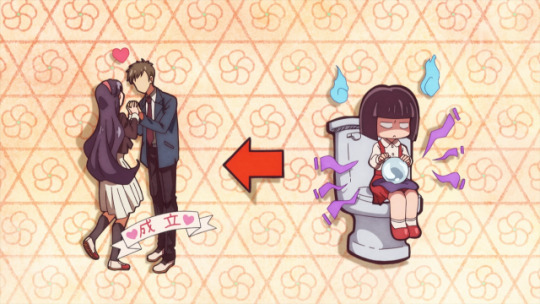
How to channel your ghost powers for success (Source: Funimation)
Hanako, because of her relatively modern backstory, is just as ubiquitous. Versions of Hanako appear in an episode of the 2018 Kitaro and most recently in the 2020 series Toilet Bound Hanako-kun. Tsunametsu currently edits the Folklore Society of Japan’s official academic journal, no doubt a testament to his priceless contributions to folklore representation in anime.
Who You Gonna Call?
There’s no way to tell the same ghost story twice. With such a layered history, contemporary anime have a nearly endless well of folkloric material to pull from. Recent series like the hit Demon Slayer: Kimetsu no Yaiba and Toilet Bound Hanako-kun prove that fans will never get enough of the supernatural, just as long as things stay fresh.
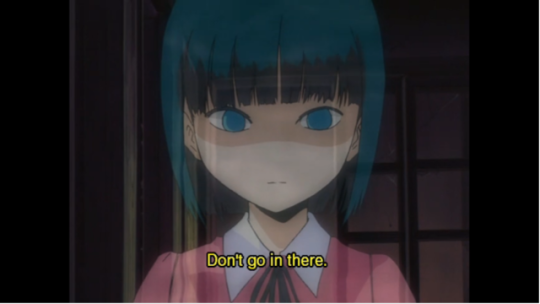
Hanako politely warns the ghost-hunting kids
Long live artistic liberty and specters trying to watch you pee.

Blake P. is a weekly columnist for Crunchyroll Features. His twitter is @_dispossessed. His bylines include Fanbyte, VRV, Unwinnable, and more. He'd like a tiny yōkai cat.
Do you love writing? Do you love anime? If you have an idea for a features story, pitch it to Crunchyroll Features!
By: Blake Planty
25 notes
·
View notes
Text
Ver El Alienista 2x3 HD Online Sub Español
✦❉■ El Alienista 2x3 sub Espanol ■✦❉
El Alienista 2x3 Online descargar,El Alienista 2x3 Online Espanol, El Alienista 2x3 Ver Online, El Alienista Temporada 2 Capitulo 3, El Alienista 2x3 Subtitulado, El Alienista 2x3 Latino Para Ver El Episodio Completo El Alienista 2x3 Full HD En Subtítulo España
Desde 2018 / 48min. / Drama, Histórico, Crimen Título original: The Alienist Dirigida por Hossein Amini Reparto Daniel Brühl, Luke Evans, Dakota Fanning Nacionalidad EE.UU. Canal original TNT

SINOPSIS & INFO El Alienista se ambienta a finales del siglo XIX en la ciudad de Nueva York y gira en torno a la búsqueda de un asesino en serie con nuevos métodos como las huellas digitales y la psicología. La primera víctima de asesinato es un inmigrante de 13 años de edad al que le han quitado los ojos, mutilado sus genitales y causado otras lesiones desagradables. Los investigadores tratan diversos grupos de interes que desean mantenerel statu quo con respecto a la población pobre de inmigrantes en Nueva York. Incluye apariciones de muchos personajes famosos de la época en la metrópoli como Theodore Roosevelt y JP Morgan.
El Alienista 2x3 , El Alienista 2x3 sub Espanol, ver El Alienista 2x3 , El Alienista Temporada 2 Capitulo 3, El Alienista 2x3 sub, El Alienista online 2x3, El Alienista 2x3 subtitulado Encuentra todas las series de televisión y películas que puedes transmitir en línea, incluidas las series que se transmitieron hoy. Si se pregunta qué puede ver en este sitio web, debe saber que incluye géneros que incluyen series de crimen, drama, misterio, acción y aventura. Muchas gracias Les decimos a todos aquellos que están felices de aceptarnos como noticias o información sobre el programa de la temporada, los episodios y cómo ven sus programas de televisión favoritos. Con suerte, podemos convertirnos en el mejor socio para usted en la búsqueda de recomendaciones para un programa de televisión de varios países de todo el mundo. Eso es todo de nosotros, saludos.
(►) ☛☛ 1080p HD (►) ☛☛ VER ONLINE AQUI (►) ☛☛ DESCARGAR AQUI
While the players who play a role in the film are referred to as actors (men) or actresses (women). There is also the term extras that are used as minor characters with few roles in the film. This differs from the main actors, who have larger and more roles. As an actor and actress, good acting talent must be required that corresponds to the subject of the film in which he plays the leading role. In certain scenes, the role of the actor can be replaced by a stunt man or a stunt man. The existence of a stuntman is important to replace the actors who play difficult and extreme scenes that are usually found in action-action films. Movies can also be used to deliver certain messages from the filmmaker. Some industries also use film to convey and represent their symbols and culture. Filmmaking is also a form of expression, thoughts, ideas, concepts, feelings and moods of a person that are visualized in the film. The film itself is mostly fictional, though some are based on actual stories or on a true story. There are also documentaries with original and real images or biographical films that tell the story of a character. There are many other popular genre films, from action films, horror films, comedy films, romantic films, fantasy films, thriller films, drama films, science fiction films, crime films, documentaries and others. This is some information about the definition of film or film. The information has been cited from various sources and references. Hope it can be useful. ❍❍❍ TV FILM ❍❍❍The first television shows were experimental, sporadic programs that from the 1930s could only be seen at a very short distance from the mast. TV events such as the 1936 Summer Olympics in Germany, the crowning of King George VI. In Britain in 19340 and the famous launch of David Sarnoff at the 1939 New York World’s Fair in the United States, the medium grew, but World War II brought development to a halt after the war. The 19440 World MOVIE inspired many Americans to buy their first television, and in 1948 the popular Texaco Star Theater radio moved to become the first weekly television variety show that hosted Milton Berle and earned the name “Mr Television” demonstrated The medium was a stable, modern form of entertainment that could attract advertisers. The first national live television broadcast in the United States took place on September 4, 1951, when President Harry Truman’s speech at the Japanese Peace Treaty Conference in San Francisco on AT & T’s transcontinental cable and microwave relay system was broadcasting to broadcasters in local markets has been. The first national color show (the 1954 Rose Parade tournament) in the United States took place on January 1, 1954. For the next ten years, most network broadcasts and almost all local broadcasts continued to be broadcast in black and white. A color transition was announced for autumn 1965, in which more than half of all network prime time programs were broadcast in color. The first all-color peak season came just a year later. In 19402, the last holdout of daytime network shows was converted to the first full color network season. ❍❍❍ formats and genres ❍❍❍ See also: List of genres § Film and television formats and genres TV shows are more diverse than most other media due to the variety of formats and genres that can be presented. A show can be fictional (as in comedies and dramas) or non-fictional (as in documentary, news, and reality television). It can be current (as in the case of a local news program and some television films) or historical (as in the case of many documentaries and fictional films). They can be educational or educational in the first place, or entertaining, as is the case with situation comedies and game shows. [Citation required] A drama program usually consists of a series of actors who play characters in a historical or contemporary setting. The program follows their lives and adventures. Before the 1980s, shows (with the exception of soap opera series) generally remained static without storylines, and the main characters and premise barely changed. [Citation required] If the characters’ lives changed a bit during the episode, it was usually reversed in the end. For this reason, the episodes can be broadcast in any order. [Citation required] Since the 1980s, many FILMS have had a progressive change in the plot, characters, or both. For example, Hill Street Blues and St. Elsewhere were two of the first American prime time drama television films to have this kind of dramatic structure [4] [better source required], while the later MOVIE Babylon 5 further illustrated such a structure had a predetermined story about the planned five season run. [Citation required] In 2010, it was reported that television became a larger part of the revenue of large media companies than the film. Some also noticed the quality improvement of some television programs. In 2010, Oscar-winning film director Steven Soderbergh declared the ambiguity and complexity of character and narrative: “I think these qualities are now being seen on television and people who want to see stories with such qualities are watching TV. ❍❍❍ Thanks for everything and have fun watching❍❍❍ Here you will find all the films that you can stream online, including the films that were shown this week. If you’re wondering what to see on this website, you should know that it covers genres that include crime, science, fi-fi, action, romance, thriller, comedy, drama, and anime film. Thanks a lot. We inform everyone who is happy to receive news or information about this year’s film program and how to watch your favorite films. Hopefully we can be the best partner for you to find recommendations for your favorite films. That’s all from us, greetings! Thank you for watching The Video Today. I hope you like the videos I share. Give a thumbs up, like or share if you like what we shared so we are more excited. Scatter a happy smile so that the world returns in a variety of colors.
1 note
·
View note
Text
ESSAY: How Does My Hero Academia Fit Into Global Superhero Culture?

In 1989, Batman became the first film to make over $40 million in its opening weekend. In 2002, Spider-Man became the first film to make over $100 million in its opening weekend. In 2007, Spider-Man 3 hit over $150 million. In 2012, The Avengers nabbed over $200 million. And in 2019, Avengers: Endgame got over $350 million. Despite the fact that there have been concerns over “superhero movie fatigue” for literal decades now, it’s a genre that shows no signs of slowing down. As its universes expand on streaming services like Disney+, it’s apparent the age of the cinematic hero might be an indefinitely lengthy one.
As Marvel Comics luminary Stan Lee once said: “The pleasure of reading a story and wondering what will come next for the hero is a pleasure that has lasted for centuries and, I think, will always be with us.” In that quote, it seems our destiny is almost sealed — we crave heroes and we crave their stories and we crave their sequels.
This is the environment in which My Hero Academia was born.

My Hero Academia is, first and foremost, a superhero story. One could argue that most narratives of its ilk are superhero tales — anime like Dragon Ball, Naruto, One Piece, and others are full of good guys shutting down malicious attempts at local or world domination — but My Hero Academia embraces the iconography, both thematic and physical, of the superhero in a way that many other stories don’t. In fact, it might be one of the purest explorations of that kind of universe ever in fiction. It’s a world where heroism is practically currency, where roughly 80 percent of the earth’s population is imbued with some kind of inherent genetic power.
Populating your superhero story with powerful people instead of going the typical cinematic route of having one or two supernatural characters with a supporting cast of everyday folk might have been subversive 20 years ago. But in the age of the Avengers, where multiple heroes cross in and out of each other's storylines and the narrative objective was to eventually wrangle them all in one mega-movie, My Hero Academia fits comfortably. That doesn’t render it as uninteresting, though. Instead, rather than build to the issues that will inevitably crop up in a world full of Supermen, these themes are inherent in the story.

As such, most of the plotlines have to do with the idea of rampant heroism and the backlash that it would create. Plenty of superhero films address this (multiple Batman movies make the case that if there were no Batman there would be no Joker), but in My Hero Academia it is a constant struggle. Overhaul, wearing a variation of a 17th-century plague doctor mask, looks at these “Quirks” as if they’re a disease. Stain is against superheroes using their status for fame. Tomura Shigaraki wishes to destroy society as we know it, hating its values and its borderline divine treatment of figures like All-Might. These patterns are not just repeated in My Hero Academia, but inevitable. They are anime embodiments of that “superhero fatigue” article I shared above, except in this case they hurt and destroy in their attempts to find an alternative to the super status quo, rather than write essays in The New York Times.
It’s certainly an enthralling formula, though: My Hero Academia continues to be a best seller and has won numerous awards. Its anime has been similarly well-received. Despite the fact that superhero films very rarely have the same box office prominence in Japan as they do in America, My Hero Academia has been able to make an impact. That might be because, at its core, My Hero Academia adapts the ethos found in a hero that many Japanese creators really do enjoy: Spider-Man.
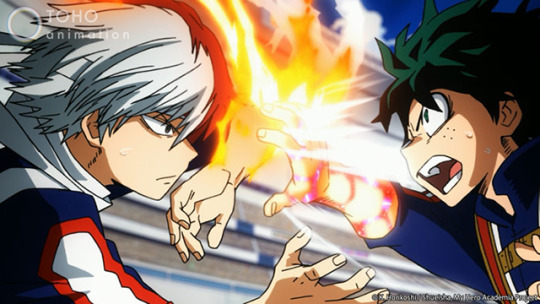
Kohei Horikoshi, My Hero Academia’s creator, loves Sam Raimi’s Spider-Man films. Creator of JoJo’s Bizarre Adventure, Hirohiko Araki gushed over his love of Spider-Man 2 to director Sam Raimi during an interview. Yusuke Murata, illustrator of One-Punch Man, has done some absolutely amazing work when it comes to posters for Peter Parker’s cinematic adventures. Hideo Kojima, a video game designer whose creations are absolutely inspired by anime, called Into The Spider-Verse a “great masterpiece” and was “moved” by Spider-Man 2. After it became the best-selling game to be developed in the West but funded by Sony since 1998, Japanese game developers voted Marvel’s Spider-Man as their 2018 game of the year. So why the embrace of this particular character?
Journalist Kuremasa Uno told the Japanese site Business+IT that it’s because Japanese youth are more accustomed to embracing younger heroes. Since so much of Spider-Man’s Hollywood journey deals with him experiencing problems as a teenager and young adult, he fits in among the protagonists of series like Gundam or Naruto. Hideo Kojima even told Famitsu that Spider-Man is “similar to Japanese heroes,” as he has “worries.”

The aspect of youth is particularly interesting, as it’s what often renders heroes like Spider-Man to be the most relatable of all of their peers and rivals. In the comic book world, age tends to warp characters, turning them into beacons of impossible standards rather than troubled everymen. We have little in common with the hulking, aging Batman snapping bones in Frank Miller’s The Dark Knight Returns. We are enthralled with the story on a narrative level. Even the legendary curmudgeon of the comic book industry, the supremely talented Alan Moore, found The Dark Knight Returns fascinating because it gave a hero a chance to end, rather than cycle through an eternal series of escapades. If you know Moore’s stance on heroes, that’s high praise, but it’s hard to connect with him no matter how cool he looks taking down the Mutant Leader.
In youth we find common ground. We all grow up, and for the most part, we all experience that mix of angst, desperation, and uncertainty that comes with finding yourself on a bullet train to adulthood. In my interview with Matt Alt, author of Pure Invention: How Japan’s Pop Culture Conquered The World, the writer/historian affirmed these feelings as especially true in anime: “It doesn’t look at adolescence as a lesser form of adulthood and it doesn’t condescend to the young people experiencing problems.” That is true of My Hero Academia, which treats Midoriya’s teenage problems as valid and worth concern, and is also true to Stan Lee’s affinity for Spider-Man: “He’s the one who’s most like me — nothing ever turns out 100 percent OK; he’s got a lot of problems and he does things wrong, and I can relate to that.”

So perhaps it is in collecting a cast of characters that, like Spider-Man, are all dealing with youthful problems that Horikoshi found the fantastic formula for My Hero Academia. It’s a world with teachers and Pro Heroes, but there is no real equivalent of a Justice League, no impenetrable class of demi-gods to impart moral lessons on not just younger heroes but the world at large.
Instead, much like in real-life youth, the characters of My Hero Academia and the class of 1A must discover those lessons for themselves. With that, the reasons for the aforementioned creators’ adoration of films like the Spider-Man trilogy and Into the Spider-Verse seemingly become more clear. Though these films feature a ... ummm ... supportive supporting cast, the integrity must come from the hero alone in the end, no matter how tough their obstacles become. You are born with Quirks, but how you choose to implement them for the good of mankind is up to you. Great power, great responsibility, etc.
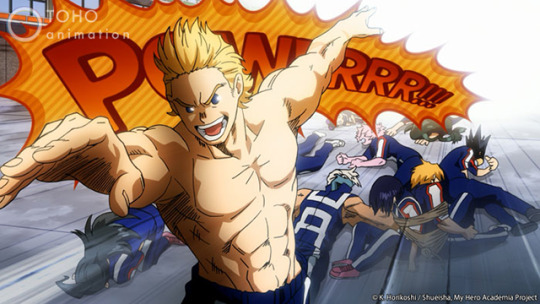
My Hero Academia and Spider-Man are not a 1:1 comparison as, again, the basics of its world and the attributes of its cast fit it more firmly with late-term Avengers films where dozens of heroes interact in a spectacle created by the sheer existence of their number. My Hero Academia rarely feels as lonely as Spider-Man tends to be. But in capturing the relatable qualities of adolescence and focusing on the “quirks” of what is essentially high school life, it does manage to hit some of the same high notes, notes that I imagine contributed greatly to its popularity.
Does that mean All-Might is an Uncle Ben character, with his “Now it’s your turn” point to Midoriya serving a similar purpose to the “Great responsibility” speech? Eh, a little bit. But in relating it to the superhero genre that currently forms an entertainment monolith around the world, especially when it has to do with the character of Spider-Man, we start to unlock some of the reasons why My Hero Academia has been such a powerhouse series over the past few years. You can see just as much of Midoriya in Peter Parker as you can in guys like Naruto or Asta — characters that aren’t relatable simply because they’re young, but because we connect to their experiences of youth, experiences that are somehow both deeply specific and also beautifully universal.

Daniel Dockery is a Senior Staff Writer for Crunchyroll. Follow him on Twitter!
Do you love writing? Do you love anime? If you have an idea for a features story, pitch it to Crunchyroll Features.
By: Daniel Dockery
1 note
·
View note